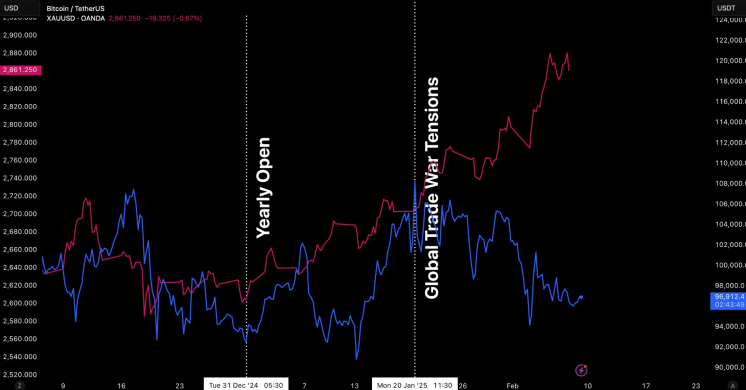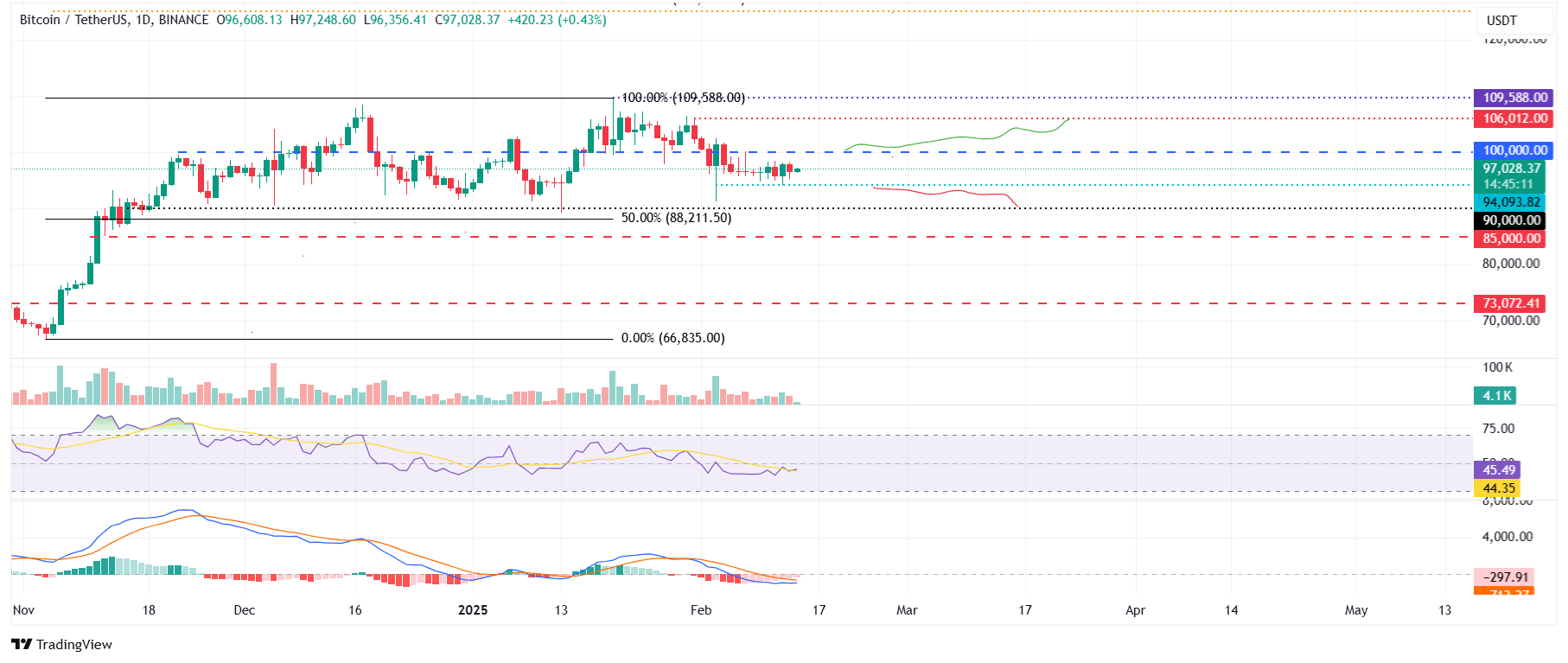- Bitcoin price has been consolidating between $94,000 and $100,000 for the last ten days.
- US Bitcoin spot ETF data recorded a total net outflow of $650.80 million until Thursday.
- US macroeconomic data and Trump’s push for a Russia-Ukraine peace deal affect Bitcoin price.
Bitcoin’s (BTC) price has been consolidating between $94,000 and $100,000 for the last ten days, and, when writing on Friday, it hovers around $97,000. Despite this consolidation, US Bitcoin spot Exchange Traded Funds (ETFs) data recorded a total net outflow of $650.80 million until Thursday, hinting signs of weakness among institutional investors. Moreover, this week, US macroeconomic data and Trump’s push for a Russia-Ukraine peace deal affected Bitcoin prices.
Bitcoin institutional demand weakens
Bitcoin’s price is consolidating between $94,000 and $100,000 while its institutional demand weakens this week. According to Coinglass, Bitcoin spot ETF data recorded four straight days of outflows, totaling a net outflow of $650.80 million until Thursday. If the magnitude of the outflow continues and intensifies, the Bitcoin price could see further corrections.
Total Bitcoin spot ETF net inflow chart. Source: Coinglass
Bitcoin is treated as a risk-on asset rather than a pure store of value
On Monday, the Bifinex Alpha report highlighted that recent trends suggest that BTC is increasingly being treated as a risk-on asset rather than a pure store of value.
The report explains that Bitcoin’s correlation with the S&P 500 remains strong, while its relationship with Gold has weakened. While Bitcoin has gained 3.5% so far this year, Gold is up 9%, hitting a new all-time high of $2,880 per ounce on Tuesday. The Gold rally has added $1.5 trillion to its market capitalization this year, dwarfing Bitcoinʼs $66.5 billion increase. This divergence is driven by institutional and sovereign wealth fund purchases, which have largely bypassed Bitcoin due to regulatory concerns and volatility.
However, a shift may be underway. Over $196 billion worth of Bitcoin is now held by ETFs, public and private companies, and even nation-states. With central banks expanding money supply and fiat devaluation risks rising, Bitcoinʼs fixed-supply narrative is becoming increasingly attractive.
BTC vs Gold performance since 2025 Open chart. Source: Bitfinex & Forex.com
Moreover, a K33 Research report stated on Tuesday, “Trump tariffs sparking trade tensions, some growing doubt about US debt levels, central bank accumulation, and interest rate cuts have all driven flows into the precious metal.”
The report further explains that BTC has not seen “safe-haven asset” flows, as it has been more correlated with stocks that face de-risking in the face of Trump tariff headlines. While some central banks and countries have shown more warmth towards BTC recently, the nation-state reserve rotation has not impacted BTC in any meaningful way compared to Gold.
US macroeconomic data and Trump’s Russia-Ukraine peace deal moves shake Bitcoin
QCP’s report on Wednesday stated, “The time to buy is when there’s blood in the streets! Buying the dip was the winning trade overnight following the post-CPI flush.”
The report explained that as the headline Consumer Price Index (CPI) for January came in hotter than expected, core CPI was also slightly higher on Wednesday. This shifted market expectations, with the US Federal Reserve (Fed) now expected to delay its first rate cut of the year until December, triggering a bloodbath.
BTC plummeted from $96,500 to $94,000, with $163 million in long positions liquidated, according to the QCP’s analyst. However, BTC managed to find its footing at $94,000 and subsequently made an impressive rally to $98,000 during the New York session, netting a 4.4% gain from low to high that day.
During the same period, the US President shifted attention to foreign borders, making moves to settle the war between Russia and Ukraine.
Moreover, on Thursday, President Donald Trump signed a memo calling his administration to devise “the equivalent of a reciprocal tariff with respect to each foreign trading partner.”
The order tasks Secretary of Commerce Howard Lutnick and other economic officials in the administration to carve out plans for reciprocal tariffs on countries that impose taxes on US imports.
Bitcoin price declined 1.29% on Thursday. At the time of writing on Friday, it hovers around $97,000, still consolidating between the $94,000 and $100,000 range for the last ten days.
Bitcoin technical outlook: BTC consolidates between $94,000 and $100,000 range
Bitcoin price broke below the $100,000 support level on February 4 and has been consolidating between $94,000 and $100,000 since then. At the time of writing on Friday, BTC hovers around $97,000.
If BTC breaks and closes below the lower boundary of the consolidating range of $94,000, it could extend the decline to test its psychologically important level of $90,000.
The Relative Strength Index (RSI) on the daily chart reads 45, consolidating after being rejected from its neutral level of 50 last week and indicating slightly bearish momentum. Moreover, the Moving Average Convergence Divergence (MACD) showed a bearish crossover and red histogram bars, hinting at further correction ahead.
BTC/USDT daily chart
However, if BTC breaks above the upper boundary of the consolidating range of $100,000, it would extend the recovery to retest its January 31 high of $106,012.
Bitcoin, altcoins, stablecoins FAQs
Bitcoin is the largest cryptocurrency by market capitalization, a virtual currency designed to serve as money. This form of payment cannot be controlled by any one person, group, or entity, which eliminates the need for third-party participation during financial transactions.
Altcoins are any cryptocurrency apart from Bitcoin, but some also regard Ethereum as a non-altcoin because it is from these two cryptocurrencies that forking happens. If this is true, then Litecoin is the first altcoin, forked from the Bitcoin protocol and, therefore, an “improved” version of it.
Stablecoins are cryptocurrencies designed to have a stable price, with their value backed by a reserve of the asset it represents. To achieve this, the value of any one stablecoin is pegged to a commodity or financial instrument, such as the US Dollar (USD), with its supply regulated by an algorithm or demand. The main goal of stablecoins is to provide an on/off-ramp for investors willing to trade and invest in cryptocurrencies. Stablecoins also allow investors to store value since cryptocurrencies, in general, are subject to volatility.
Bitcoin dominance is the ratio of Bitcoin’s market capitalization to the total market capitalization of all cryptocurrencies combined. It provides a clear picture of Bitcoin’s interest among investors. A high BTC dominance typically happens before and during a bull run, in which investors resort to investing in relatively stable and high market capitalization cryptocurrency like Bitcoin. A drop in BTC dominance usually means that investors are moving their capital and/or profits to altcoins in a quest for higher returns, which usually triggers an explosion of altcoin rallies.








